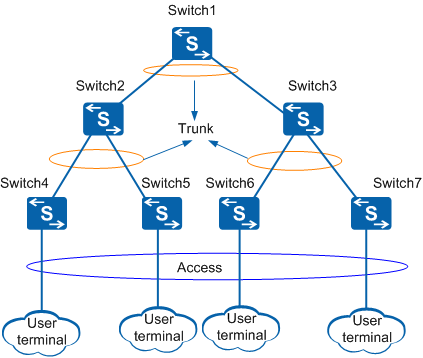LNP
Definition
- When the link type on an Ethernet interface is negotiated as access, the interface joins VLAN 1 by default.
- When the link type on an Ethernet interface is negotiated as trunk, the interface joins a VLAN in the range from VLAN 1 to VLAN 4094 by default.
Background
The switch supports the following link types on an Ethernet interface: access, hybrid, trunk, and QinQ. The four link types are applicable to different network deployments and are manually specified. When the network topology changes, link types of Ethernet interfaces also need to be reconfigured. If this is done manually, configuration is time-consuming and complex. To simplify configuration, LNP supports auto-negotiation of the link types on Ethernet interfaces and allows Ethernet interfaces to join VLANs through auto-negotiation. This eliminates the need to manually configure link types of Ethernet interfaces, reducing the workload.
Implementation
When Layer 2 devices on the network shown in Figure 1 are successfully connected, the physical status of their interfaces becomes Up. After LNP negotiation is complete, user-side interfaces on Switch4, Switch5, Switch6, and Switch7 join VLAN 1 as access interfaces, and interfaces between switches become trunk interfaces that allow all VLANs.
After LNP is enabled, LNP negotiation is triggered in the following situations:
- The local device receives LNP packets from the remote device.
- The local interface type or interface status changes.
In addition to access, hybrid, trunk, and QinQ, LNP provides the following interface types:
- negotiation-desirable: The local device actively sends LNP packets.
- negotiation-auto: The local device does not actively send LNP packets.

An interface that is negotiated as a trunk interface allows all VLANs by default; therefore, a loop prevention protocol (for example, STP, RSTP, MSTP, or VBST) needs to be deployed to prevent loops.
If a loop prevention protocol is deployed on a Layer 2 network, LNP negotiation can succeed even on a blocked interface.
LNP negotiation
The link type of the remote Layer 2 Ethernet interface determines the negotiation result. Table 1 describes LNP negotiation results on a Layer 2 interface in Up state.

If the two ends of an Eth-Trunk link have different numbers of member interfaces, the LNP negotiation may fail.
- If the link type of the Layer 2 Ethernet interface is set to access, hybrid, trunk, or QinQ, LNP negotiation does not take effect on the interface.
- If the negotiation fails, the link type of an interface will be set to access.
Table 1 LNP negotiation Local LNP Negotiation Mode
Remote Link Type or LNP Negotiation Mode
Negotiated Local Link Type
Status of Remote Link Type
negotiation-desirable/negotiation-auto
Access (LNP negotiation enabled)
Access
Access
Hybrid (LNP negotiation enabled)
Trunk
Hybrid
QinQ (LNP negotiation enabled)
Access
QinQ
Trunk (LNP negotiation enabled)
Trunk
Trunk
LNP negotiation not supported or disabled
Access
Uncertain
negotiation-desirable
negotiation-desirable
Trunk
Trunk
negotiation-desirable
negotiation-auto
Trunk
Trunk
negotiation-auto
negotiation-auto
Access
Access
LNP negotiation depends on communication between both ends. When the communication is delayed, the link type may be incorrectly negotiated. After three rounds of communication are complete, the link type is in stable negotiation state. Otherwise, the link type of the interface stays in negotiation state. Before the link type enters the stable negotiation state, the interface is in blocking state and does not forward packets. This prevents forwarding errors.
The VLAN Central Management Protocol (VCMP) domain name affects LNP negotiation. The link type can be negotiated as trunk only when domain names at both ends are consistent or the domain name of at least one end is empty; otherwise, the link type is negotiated as access.
